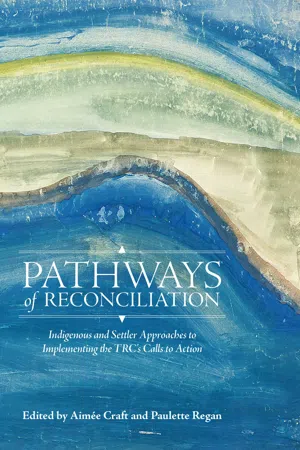
Pathways of Reconciliation
Indigenous and Settler Approaches to Implementing the TRC's Calls to Action
- English
- ePUB (mobile friendly)
- Available on iOS & Android
Pathways of Reconciliation
Indigenous and Settler Approaches to Implementing the TRC's Calls to Action
About this book
Since the Truth and Reconciliation Commission released its Calls to Action in June 2015, governments, churches, non-profit, professional and community organizations, corporations, schools and universities, clubs and individuals have asked: "How can I/we participate in reconciliation?"
Recognizing that reconciliation is not only an ultimate goal, but a decolonizing process of journeying in ways that embody everyday acts of resistance, resurgence, and solidarity, coupled with renewed commitments to justice, dialogue, and relationship-building, Pathways of Reconciliation helps readers find their way forward.
The essays in Pathways of Reconciliation address the themes of reframing, learning and healing, researching, and living. They engage with different approaches to reconciliation (within a variety of reconciliation frameworks, either explicit or implicit) and illustrate the complexities of the reconciliation process itself. They canvass multiple and varied pathways of reconciliation, from Indigenous and non-Indigenous perspectives, reflecting a diversity of approaches to the mandate given to all Canadians by the TRC with its Calls to Action.
Together the authors—academics, practitioners, students and ordinary citizens—demonstrate the importance of trying and learning from new and creative approaches to thinking about and practicing reconciliation and reflect on what they have learned from their attempts (both successful and less successful) in the process.
Frequently asked questions
- Essential is ideal for learners and professionals who enjoy exploring a wide range of subjects. Access the Essential Library with 800,000+ trusted titles and best-sellers across business, personal growth, and the humanities. Includes unlimited reading time and Standard Read Aloud voice.
- Complete: Perfect for advanced learners and researchers needing full, unrestricted access. Unlock 1.4M+ books across hundreds of subjects, including academic and specialized titles. The Complete Plan also includes advanced features like Premium Read Aloud and Research Assistant.
Please note we cannot support devices running on iOS 13 and Android 7 or earlier. Learn more about using the app.
Information
Part One
Reframing

Chapter 1
Paved with Comfortable Intentions
Moving beyond Liberal Multiculturalism and Civil Rights Frames on the Road to Transformative Reconciliation
Settler Comfort and the Liberal Frame
Table of contents
- Introduction
- Part One Reframing
- Chapter 1 Paved with Comfortable Intentions: Moving beyond Liberal Multiculturalism and Civil Rights Frames on the Road to Transformative Reconciliation
- Chapter 2 Perceptions on Truth and Reconciliation: Lessons from Gacaca in Post-Genocide Rwanda
- Chapter 3 Monitoring That Reconciles: Reflecting on the TRC’s Call for a National Council for Reconciliation
- Chapter 4 A Move to Distract: Mobilizing Truth and Reconciliation in Settler Colonial States
- Part Two Learning and Healing
- Chapter 5 Teaching Truth before Reconciliation
- Chapter 6 Learning and Reconciliation for the Collaborative Governance of Forestland in Northwestern Ontario, Canada
- Part Three Researching
- Chapter 7 What Does Reconciliation Mean to Newcomers Post-TRC?
- Chapter 8 Healing from Residential School Experiences: Support Workers and Elders on Healing and the Role of Mental Health Professionals
- Part Four Living
- Chapter 9 Bending to the Prevailing Wind: How Apology Repetition Helps Speakers and Hearers Walk Together
- Chapter 10 How Do I Reconcile Child and Family Services’ Practice of Cultural Genocide with My Own Practice as a CFS Social Worker?
- Chapter 11 Repatriation, Reconciliation, and Refiguring Relationships: A Case Study of the Return of Children’s Artwork from the Alberni Indian Residential School to Survivors and Their Families
- Conclusion
- Acknowledgements
- Bibliography
- Contributors